26.12.2021

It is a mission more than 25 years in the making. The revolutionary JWST (James Webb Space Telescope)—a partnership between NASA, the ESA (European Space Agency), and the CSA (Canadian Space Agency)— has launched atop its Ariane 5 rocket from launchpad ELA-3 at the Guiana Space Centre in South America.
Liftoff of James Webb occurred at the opening of a 32-minute-long window on Saturday, December 25 at 12:20 UTC (7:20 am EST). Ariane 5 placed the telescope into a 30-day transfer trajectory to the L2 Lagrange point in the Sun-Earth system.
James Webb arrived in French Guiana on October 12, 2021, after years of extensive testing and final integration by prime contractor Northrop Grumman. After arriving in French Guiana, James Webb was moved to the Guiana Space Centre where final checks, integration, and fueling of the telescope were performed.
James Webb was lifted and integrated atop the Ariane 5 rocket on December 11 and was encapsulated inside the 5.4-meter payload fairing on December 18. Ariane 5 and James Webb rolled out from the final assembly building five days later, on December 23, to pad ELA-3 (Ensemble de Lancement Ariane 3).
Some modifications for Ariane 5 were necessary for Webb, including increased decontamination efforts on the payload.
“There were some precautions done,” said Daniel de Chambure, Ariane 5 Operational launch System manager.
“For the satellite, we have installed a specific high-efficiency HEPA filter to create a laminar flow around Webb as needed. The key objective there was to prevent contamination–the normal contamination–by [a factor of] 10. Taking this precaution, an active charcoal filter in the air conditioning system… these were necessary for Webb’s sensitivity.”
Additionally, the payload fairing that protected Webb from Earth’s dense lower atmosphere during the initial moments of launch underwent more stringent cleaning and decontamination procedures, cleaned first in Europe before shipment to French Guiana and then again prior to encapsulation.
These new procedures were specifically designed for Webb, but de Chambure noted they will likely be used to some degree for ESA’s upcoming JUICE mission to Jupiter’s moons–a mission currently slated to launch on the second-to-last Ariane 5 rocket in history.
For Webb, Ariane 5 entered countdown operations at T-11 hours 23 minutes. A full check of Ariane 5’s electrical systems took place at T-10 hours 33 minutes before the beginning of Ariane 5 propellant load.
The loading of liquid hydrogen and liquid oxygen into the Ariane 5 first stage begins at T-4 hours 38 minutes. A little over an hour later, liquid hydrogen and liquid oxygen begin flowing into the second stage, at T-3 hours 23 minutes. Chilling of the first stage’s Vulcain main engine begins at T-3 hours 18 minutes.
At T-1 hour 15 minutes, Arianespace teams checked the connections between the rocket and the telemetry, tracking, and command systems. A little over an hour later, launch teams held an “all systems go” report to confirm that James Webb and Ariane 5 were ready for launch.
At T-4 minutes, the first and second stage propellant tanks pressurized for flight. Next, at T-1 minute, Ariane 5 switched to onboard power.
At T-5 seconds, the cryogenic arms that supply the Ariane 5 tanks with cryogenic fuels opened and retracted from the vehicle. At T-4 seconds, the rocket’s onboard systems took over the launch sequence.
After T0, the first stage Vulcain main engine ignited, with the twin solid rocket boosters firing at T+7.01 seconds.
At T+7.3 seconds, the Ariane 5 rocket lifted off from pad ELA-3 at the Guiana Space Centre carrying the James Webb Space Telescope.
Solid rocket booster separation occurred at T+2 minutes 22 seconds, with payload fairing jettison at T+3 minutes 26 seconds. The Vulcain engine exhausted its supply of liquid hydrogen and liquid oxygen at T+8 minutes 47 seconds, followed immediately by stage separation and the ignition of the HM-7B engine on the ESC-A (Etage Supérieur Cryogénique-A) upper stage.
The upper stage performed a single, continuous 16-minute 6-second burn to place Webb directly into its L2 transfer trajectory.
Separation of Webb from the Ariane 5’s upper stage occurred 27 minutes 7 seconds after liftoff.
While its mission has now begun, the history of JWST traces its direct roots to the mid-1990s and the Next Generation Space Telescope, which sought to greatly expand upon the capabilities of the Hubble Space Telescope.
As such, JWST is not technically a replacement of the iconic Hubble observatory but rather an enhanced, complimentary telescope that can see in great detail in wavelengths that Hubble cannot.
Of particular interest for JWST astronomers is the infrared wavelengths 0.6 to 28.3 μm–for which Webb is optimized. Hubble observes the near-visible, near-infrared, and ultraviolet wavelengths between 0.1 to 1 μm.
NASASpaceflight has written extensively on the various instruments onboard JWST, as well as its cryocooler that is key to cooling the observatory to just 6K for infrared observations. Click here for those articles.
With its 6.8 m gold-coated beryllium mirror, JWST will be able to see back to “first light,” around 400 million years after the big bang when the first stars and galaxies were forming.
However, this is not the farthest back a telescope has seen; that honor goes to the COBE (Cosmic Background Explorer).
COBE provided critical evidence to support the Big Bang Theory of the universe’s creation, including that the cosmic microwave background radiation has a near-perfect black-body spectrum, and that it has very faint anisotropies.
Two of COBE’s PIs (Principal Investigators), George F. Smoot and John C. Mather, were awarded the Nobel Prize in Physics in 2006 for their work on COBE. John Mather is now a Senior Project Scientist on JWST, which will continue his work on the formation of the universe by picking up–in terms of what it can see–where COBE left off.
But Webb isn’t just about seeing back to the first elements of the formation of the universe. JWST will also be able to see much closer to the present day, investigating—among other things—exoplanet atmospheres to characterize their composition and reveal more about their evolution as well as their potential to harbor life.
Webb will also be called upon to observe planets and other targets in our solar system.
To accomplish its variety of tasks and investigations, JWST is composed of: an 18 hexagonal piece, gold-coated primary mirror; a secondary focusing mirror; a sunshield to keep itself cold and to block scattered light from the Sun; a cryocooler to further lower the observatory’s temperature beyond that of the sunshield’s passive capability; a communications systems to transmit its data back to Earth; and four primary science instruments.
The four instruments on Webb are:
- NIRCam – the Near InfraRed Camera from the University of Arizona in partnership with Lockheed Martin and NASA’s Goddard Space Flight Center,
- NIRSpec – the Near InfraRed Spectrograph from NASA’s Goddard Space Flight Center, the European Space Agency, and Airbus Defense and Space who built the instrument,
- MIRI – the Mid-InfraRed Instrument from NASA and the European Space Agency, and
- FGS/NIRISS – the Fine Guidance Sensor and Near Infrared Imager and Slitless Spectrograph from the Canadian Space Agency and the Université de Montréal.
All of this makes Webb large. Quite large.
To see back to first light, the telescope’s primary mirror has to be 6.8 meters in diameter—far too large to fit into any existing rocket’s payload fairing.
But crucially, Webb must be very cold to see in the wavelengths necessary for its mission. To do this, JWST employs both a sunshield to first passively cool itself to 50K before the cryocooler further reduces the temperature to just 6K.
In order to fit in Ariane 5, Webb must be able to fold itself up for launch. This is not an uncommon practice in spaceflight. Satellites routinely fold up portions of themselves not just to fit in rocket fairings but for launch load considerations as well.
This is where Webb is different from all others that have come before it. Its size mandates 344 folds to fit in Ariane 5–folds that must be reversed one at a time after reaching space.
Of those 344 unfolds, 307 (87%) are critical, single-point failure areas–meaning that should one of those critical unfolds fail, be it with the sunshield deployment or primary/second mirror deployment, the mission will be over before it really begins. Of these 307 critical single-point failure areas, 225 (65%) are in the sunshield.
Of the 344 unfolds, 178 (52%) are NEA (non-explosive actuator) release mechanisms. The sunshield contains 120 of these NEA release mechanisms, 107 of which are MRDs (membrane release devices), 9 are pin pullers, and 4 are for cable brake assays.
Project scientists and engineers have been hesitant to release the full timeline in advance, as many of these operations have never been performed in space before, and slips and realignments are almost certain to occur.
If the 30-day unfolding process works as planned, JWST will then need approximately five more months for the sunshield and cryocooler to properly cool the observatory down before final instrument calibrations can take place–though some calibrations will be possible beforehand as well.
At present, JWST should be ready for first observations by the middle of 2022–though no specific date will be known publicly until the complex process of readying the telescope to actually look at the universe is nearing completion.
As such, the public should not expect images from Webb until the middle of 2022 at the earliest.
Inter-agency partnership—going together
The international effort for JWST from the United States, Europe, and Canada mirrors–in some ways–that of the Hubble telescope.
Hubble is a NASA-ESA partnership, with ESA contributing funding and instruments in exchange for guaranteed European astronomer time on the observatory.
Similarly, JWST’s partnership operates in much the same way, with Europe having provided part of the NIRSpec instrument, part of the cryocooler, and–crucially–the launch vehicle.
Meanwhile, the Canadian Space Agency contributed the Fine Guidance Sensor and Near-Infrared Imager and Slitless Spectrograph instrument.
All of these contributions grant each agency a certain percentage time of use on JWST. But for ESA, it will be the launch vehicle contribution that is the most visible to the world.
Ariane 5
The highly reliable workhorse Ariane 5 rocket will have its worldwide moment of fame as it is tasked with taking the nearly $10 billion dollar observatory to space on Saturday.
JWST is the most expensive–and arguably the most important–mission in Ariane 5’s long career that has included the launches of interplanetary missions, cargo resupplies to the International Space Station, and numerous single and dual-passenger satellite missions.
Ariane 5 has been flying missions to space since June 1996, and as such multiple variants of the rocket have been developed.
For the launch of James Webb, Ariane 5 flew in its ECA (Evolution Cryotechnique type A) configuration. First flown in 2002, the ECA variant uses an improved Vulcain 2 main engine and ESC-A (Etage Supérieur Cryogénique-A) second stage.
The Ariane 5 ECA consists of two stages alongside two, twin EAP P241 solid rocket boosters. These SRBs stand 31.6 m in height and provide a total of 14,160 kN of thrust for 140 seconds.
The Ariane 5 ECA first stage, called the EPC, stands 23.8 m tall at 5.4 m in diameter. The EPC is powered by a single Vulcain 2 hydrolox (liquid hydrogen-liquid oxygen) engine that provides 960 kN of thrust at sea level and 1,390 kN in a vacuum.
The second stage of the Ariane 5 ECA is called the ESC-A and is 4.71 m in height at 5.4 m in diameter. The ESC-A is powered by a single HM7B hydrolox engine that produces a total of 67 kN of thrust.
Overall, Ariane 5 has a good safety and success record, though–like all rockets–it is not immune to failures.
Prior to JWST, Ariane 5 has completed 111 missions, of which two completely failed: the first being its very first flight (a qualification mission) and the second coming in December 2002–19 years ago.
The first launch failure occurred due to Arianespace using Ariane 4 guidance software on Ariane 5. The second launch failure, in December 2002, occurred due to a fault in the Vulcain main engine’s cooling system.
Ariane 5 has also suffered three partial failures, one on its second qualification flight in October 1997, another in July 2001 (where one satellite made it to the correct orbit through use of its onboard fuel while the other was lost), and a third partial failure (where all satellites made it to intended orbits after using their onboard fuel) in January 2018.
However, Ariane 5 is an extremely reliable launch vehicle overall, and the particular Ariane 5 launching James Webb has been extensively tested and prepared for the observatory’s launch to L2.
Overall, Webb will be the 62nd mission and 85th satellite launched by Arianespace for ESA, and the 28th scientific mission to be launched by Arianespace.
(Lead image: Ariane 5 with the James Webb Space Telescope launches from ELA-3 in French Guiana. Credit: ESA)
Quelle: NS
+++
Webb liftoff on Ariane 5 to unlock secrets of the Universe
The James Webb Space Telescope lifted off on an Ariane 5 rocket from Europe’s Spaceport in French Guiana, at 13:20 CET on 25 December on its exciting mission to unlock the secrets of the Universe.
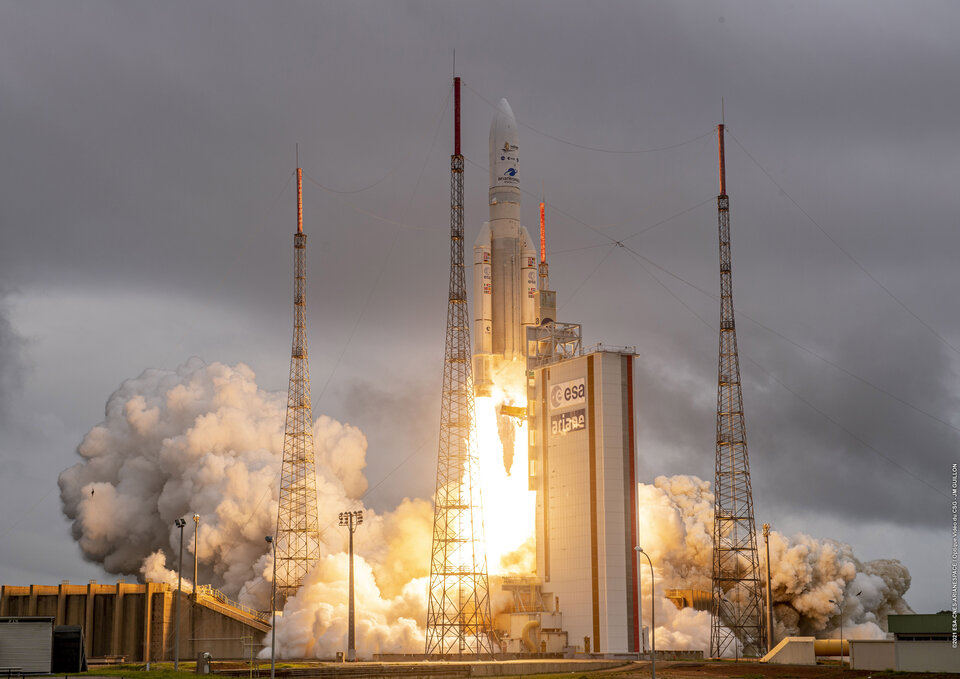
Following launch and separation from the rocket, Webb’s mission operations centre in Baltimore, USA confirmed Webb deployed its solar array and is in good condition, marking the launch a success.
In the coming month, Webb, an international partnership between NASA, ESA and the Canadian Space Agency (CSA), will travel to its destination: the second Lagrange point (L2), where it will study the Universe in infrared.
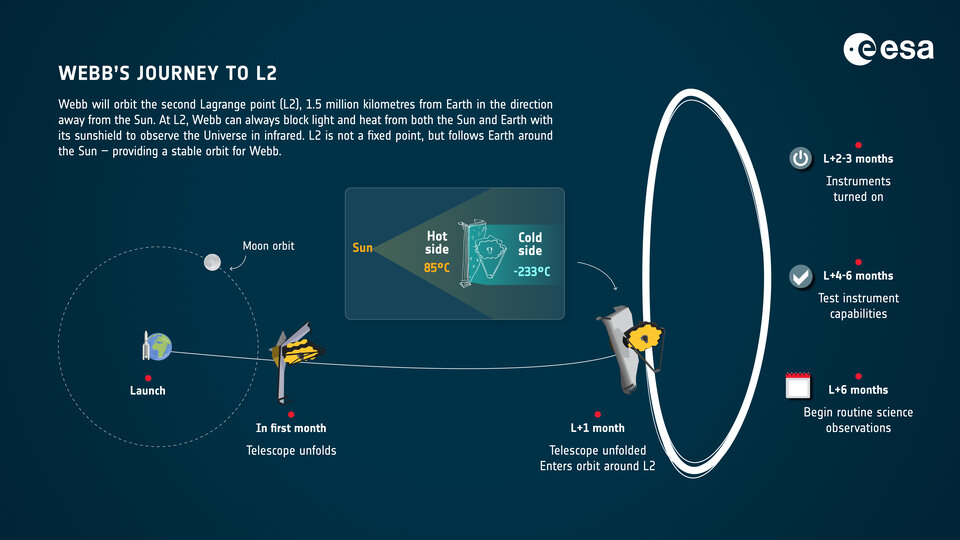
“Launching Webb is a huge celebration of the international collaboration that made this next-generation mission possible. I want to thank everyone involved with the design, construction, and launch of this ambitious telescope, for making this day a reality. We are close to receiving Webb’s new view of the Universe and the exciting scientific discoveries that it will make,” says Josef Aschbacher, ESA Director General.
“The James Webb Space Telescope represents the ambition that NASA and our partners maintain to propel us forward into the future,” says NASA administrator Bill Nelson. “The promise of Webb is not what we know we will discover; it’s what we don’t yet understand or can’t yet fathom about our Universe. I can’t wait to see what it uncovers!”
“CSA is proud to have contributed critical instruments to this large‑scale international partnership as part of a global effort to spur the next great scientific leap. Canadian astronomers are excited to use Webb’s data and benefit from the tremendous science opportunities offered by this one-of-a-kind observatory,” says CSA President Lisa Campbell.

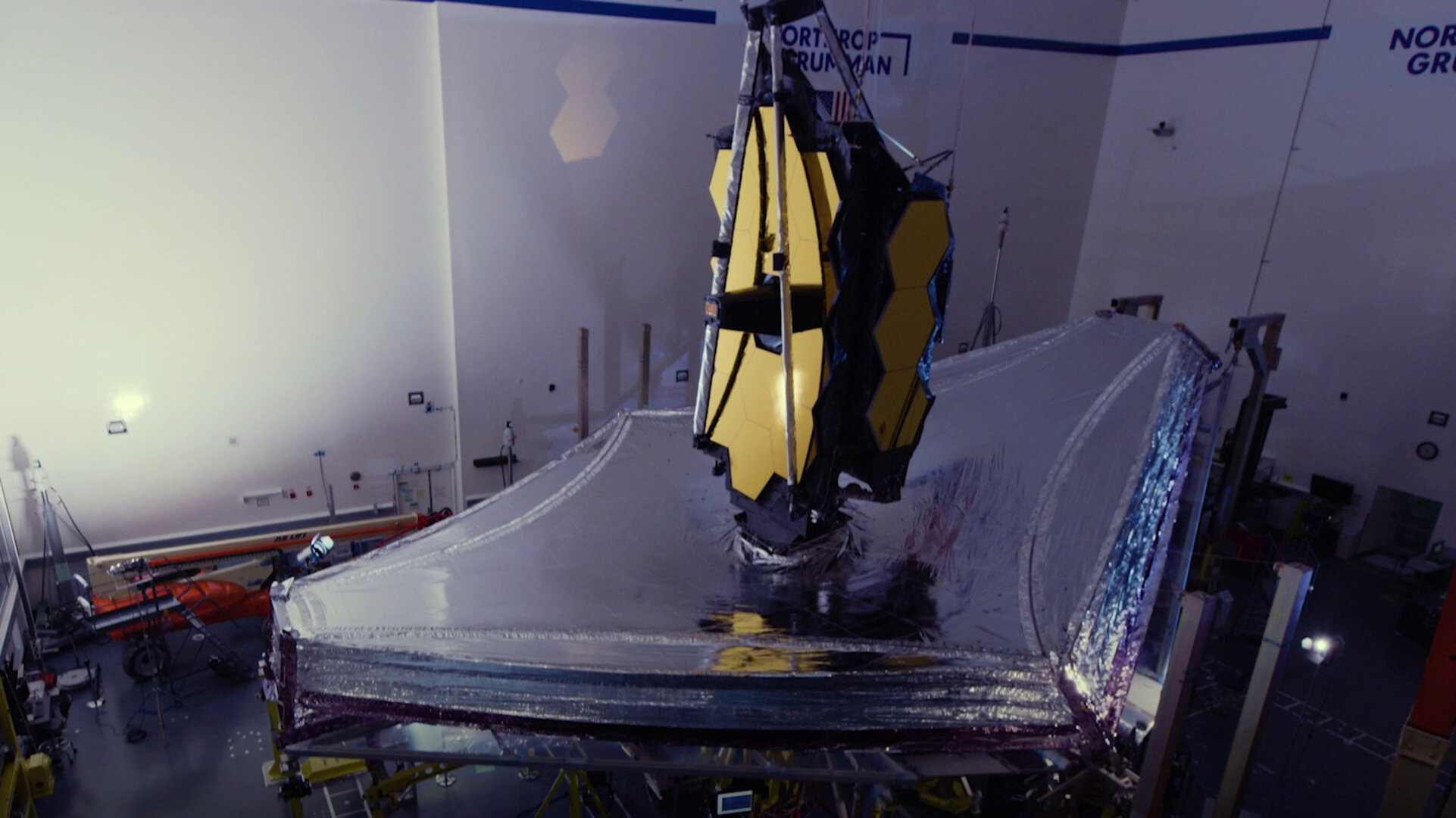
Access the video
Webb’s journey to space

The Webb observatory had to be carefully folded into the specially adapted Ariane 5 fairing for launch, which jettisoned away about three minutes after liftoff. Ariane 5 then began a special roll manoeuvre to protect Webb from the Sun’s radiation. After 27 minutes the telescope was released and the upper stage boosted away.
“I am very happy and proud that the versatility and reliability of Ariane 5 have enabled the launch of such a ground-breaking mission. This is a tribute to the skill and dedication of all the teams involved,” says Daniel Neuenschwander, ESA Director of Space Transportation.
Now in space and on its way to L2, Webb will undergo a complex unfolding sequence. In the months after, the instruments will be turned on and their capabilities tested. After half a year in space, Webb will start its routine science observations.

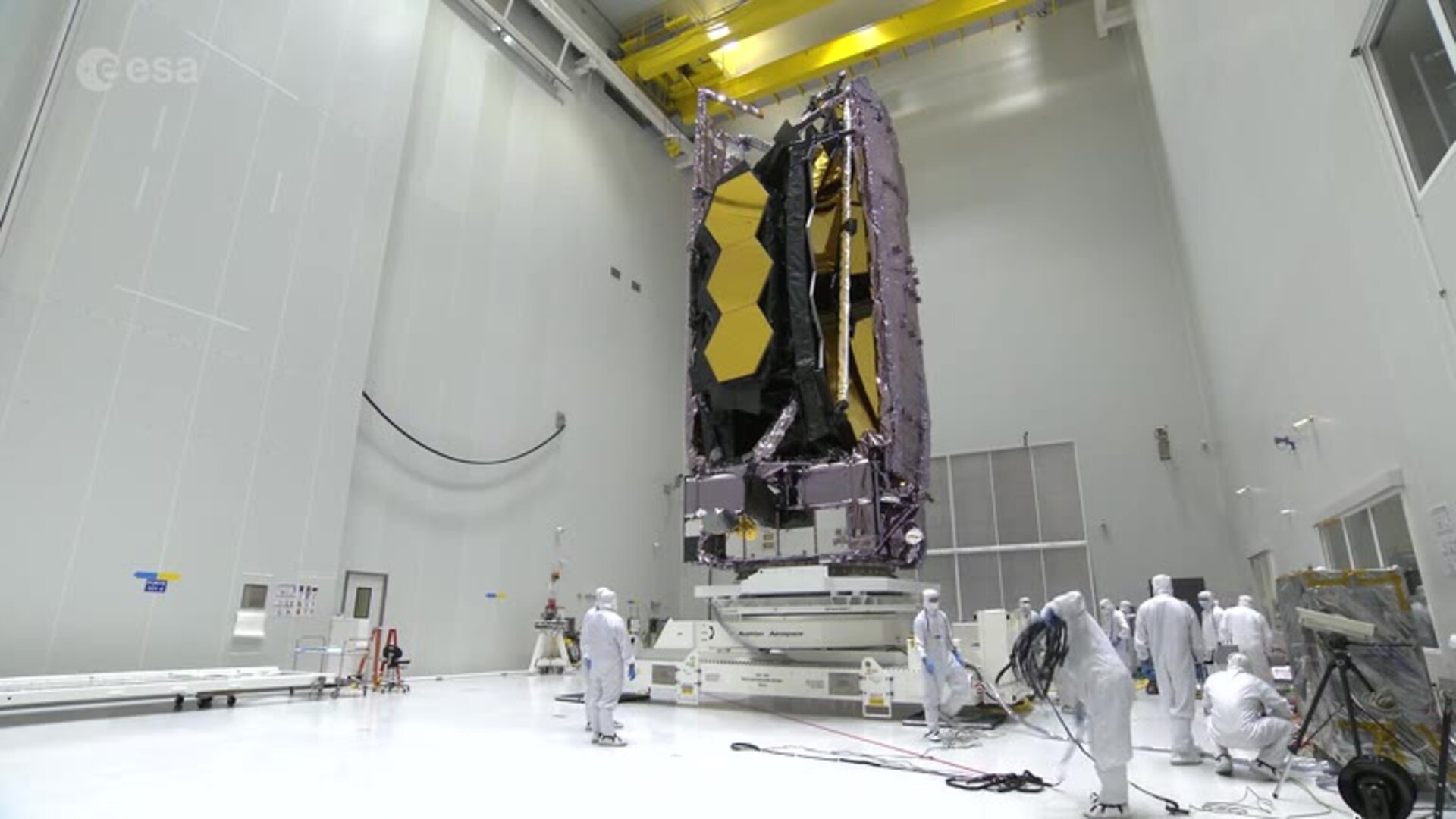
Access the video
Seeing farther
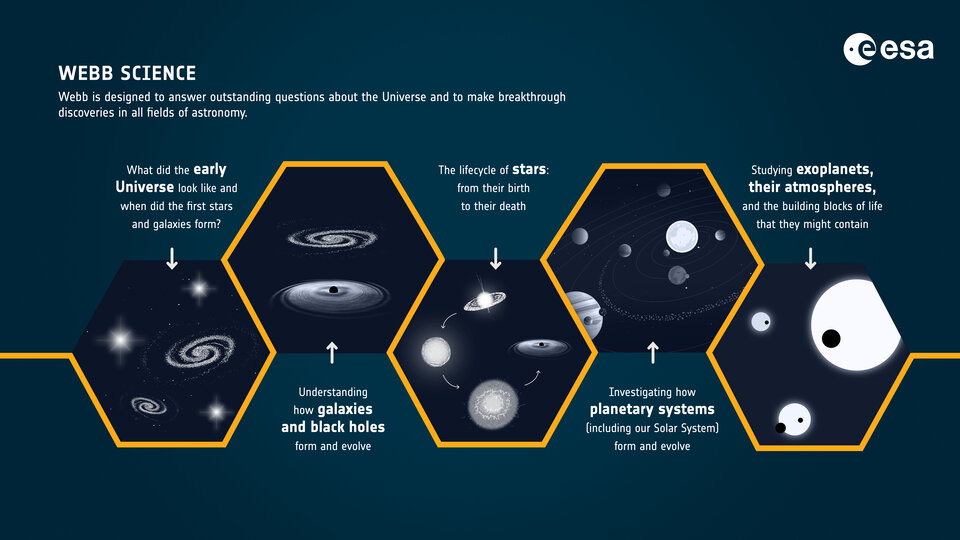
Webb will see farther into our origins: from the Universe's first galaxies, to the birth of stars and planets, to exoplanets with the potential for life, and our own Solar System.
“The idea for Webb started with the dream of astronomers to observe the birth of the first galaxies in the early Universe, but the telescope will be able to do so much more than everyone had hoped for,” says Günther Hasinger, ESA Director of Science.
ESA contributed to two of the four scientific instruments on board Webb: NIRSpec and MIRI. “It is down to the excellence of the European industry and scientific community that the development of these complex instruments was made possible,” Günther adds.
“We are now looking forward to the beautiful images and spectra that Webb will obtain. The European astronomical community is excited to see the results of the 33% available observing time they competitively won for Webb's first year,” says Antonella Nota, ESA Webb Project Scientist.
For the entire duration of the Webb mission, 15 ESA astronomers will be working on telescope operations.

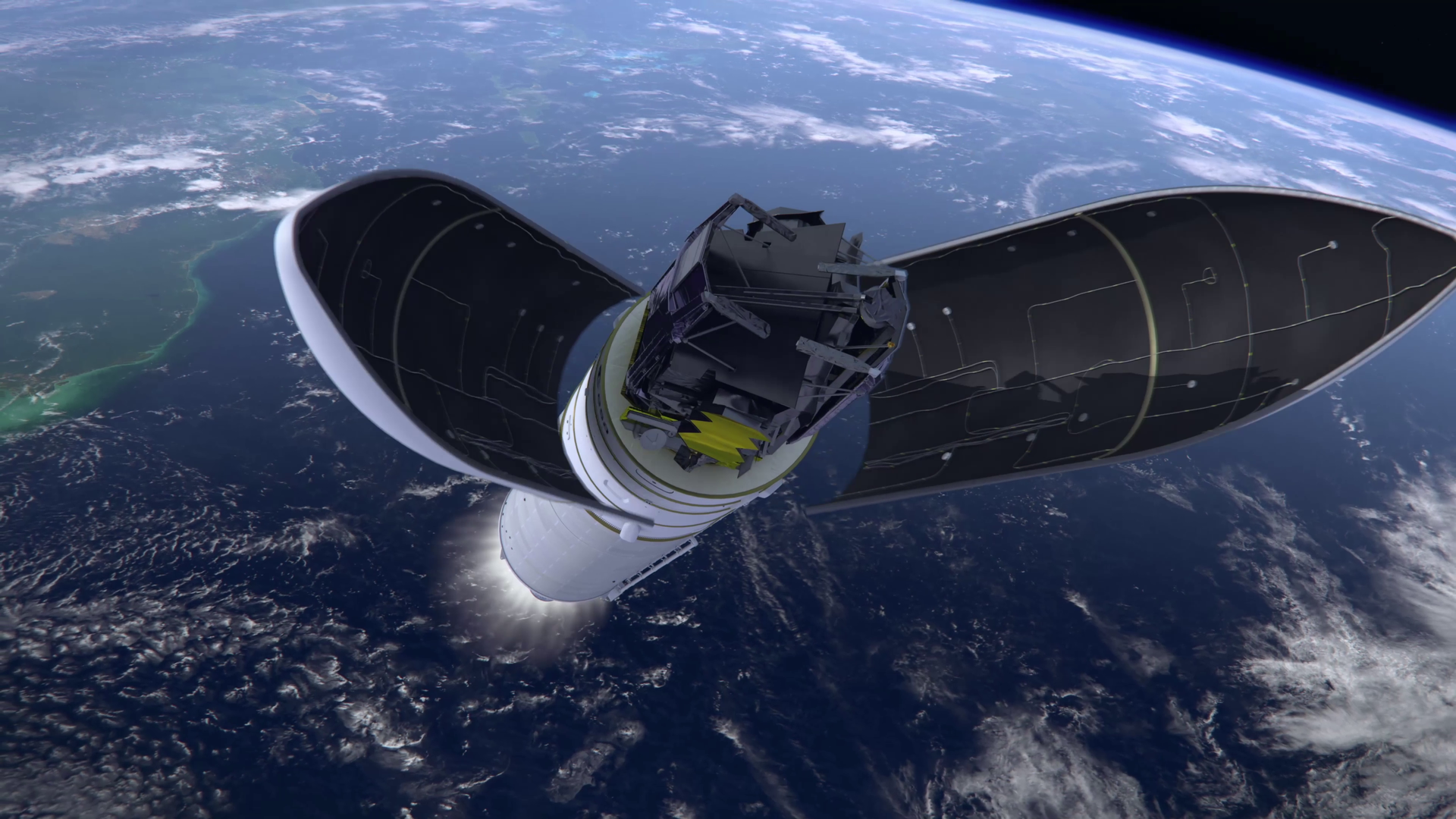
Access the video
More about Webb
Webb news updates
ESA launch kit (available in 6 languages)
ESA interactive brochure (available in 6 languages)
Quelle: ESA
